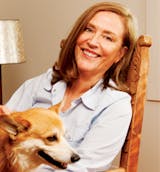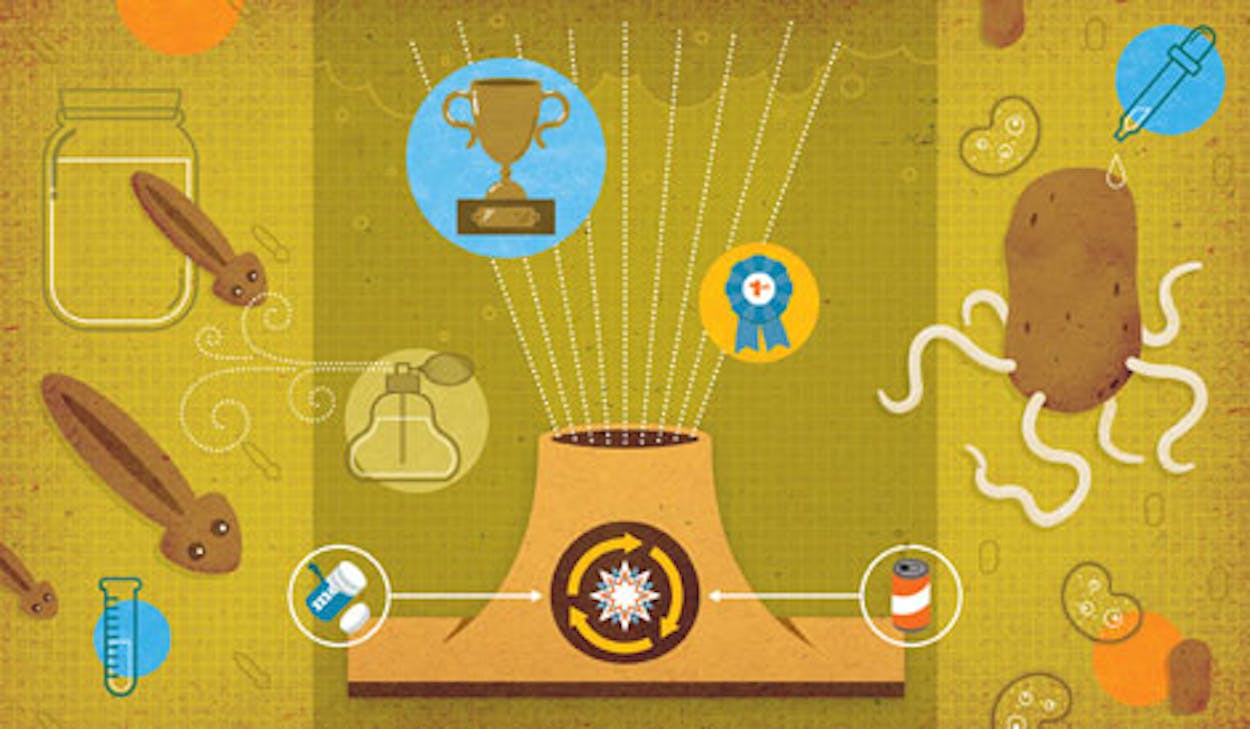Can any two words strike more fear into a parent’s heart than these: “science fair”? First of all, what happened to truth in advertising? Fair? What’s fair about the science fair? If your dad is Mr. Wizard, it’s on to regionals. If not … hello, baking soda volcano!
Or so I thought. Apparently the fallback project for students cursed with a slacker parent—say, me—who can’t get it together enough to grow bean plants under colored lightbulbs is no longer the venerable volcano. The “new hotness,” as a surly lad out there in the blogosphere would have it, is Mentos and Diet Coke, a mixture capable of burping up a magnificent 34-foot geyser sure to thrill any boy who has ever built a potato gun or set hair spray on fire.
Curious to see what other innovative workouts the scientific method was being subjected to, I headed to San Antonio in April for the state science fair. As my finger is ever on the pulse of today’s youth, I already knew that this generation is a technology-mad bunch of cyborgs, what with the eyepods and such. Consequently, as I entered the tundra-esque expanse of the Henry B. Gonzalez Convention Center, my hopes were high for YouTube-able displays featuring holograms and laser light shows. Imagine my disappointment when I was greeted by an endless sea of triptychs—yes, three pieces of poster board taped together to stand up and share those bar graphs with the world.
The first student scientist I met was Sasha Rohret, a San Antonio junior who told me that her project looked at whether Earth plants could grow on Mars. The mention of the Red Planet combined with the sight of all that poster board and the whiff of Clearasil triggered a repressed memory of my one and only science fair. It was ninth grade, my first year in public school, and not only had I never heard of a science fair before, but I wasn’t on real solid ground with science in general. My previous Catholic school education in that subject had focused more on water into wine, virgin birth, and bleeding stigmata; many of my people were still having problems with the whole cockamamy notion of the Earth’s revolving around the sun. What I lacked in even the barest hint of an idea about hypotheses, data, and conclusions, however, I made up for in my crush on Mr. Knight, the science teacher. In between scrawling the words “Mrs. Sarah Knight” on the cover of my notebook, I glanced at the only source of scientific information in our house: a copy of Asimov’s Science Fiction. I can’t explain how reading about life on a Martian space station in the year 2288 caused me to order planarians from an ad in the back of the magazine, but order I did. For my ninth-grade science fair project, I would prove that life could exist on Mars.
When the planarians arrived, I placed them in an oxygen-deprived environment that I created by sucking the air out of the jar they were in, then quickly replacing the top. My hope was that the tiny creatures with vaunted powers of regeneration would grow an external pair of lungs. They didn’t. I further attempted to duplicate the harsh Martian environment by sprinkling them with Jean Naté after-bath splash. Still no extra lungs. I began to wish fervently that these lazy planarians would die so I could take their shriveled bodies to Mr. Knight and he would exempt me from the science fair. Perhaps he’d put his muscular arm over my shoulder, draw me close, and tell me not to worry—that I had suffered enough already, and besides, he knew enough science for the both of us.
The night before projects were due, in a fit of panic I wrote a report on amphibians based on one encyclopedia entry and my feelings about tetrapods that do not have amniotic eggs. But I did create the triptych to end all triptychs. Using pinking shears, I snipped the words “Amazing Amphibians” out of the red reflective tape my mom had purchased to put safety stripes on my bike and decorated the cover with dazzling sunbursts, adding ink-brush renderings of frogs, toads, and other animals I hoped might be amphibians.
A few weeks after the science fair, while lingering outside Mr. Knight’s door, hoping to catch a glimpse of him, I noticed that he was showing his class a slide show. I slipped into the darkened room just as he said, “And, lastly, when you don’t really have a project, never, never, never try to cover it up with all sorts of glitzy art stuff.” Need I reveal whose garishly be-glitzed display he projected?
There was not the merest glint of reflective tape on any of the projects at this year’s science fair. Particularly impressive was the continuation of a multiyear project by tenth-grader Neela Thangada. Working with the antiviral drug Ribavirin, the San Antonio sophomore had cloned a potato that was resistant to a virus that destroys 20 percent of the potato harvest annually. The success of her experiment has already earned her the 2005 America’s Top Young Scientist award, a first for Texas in the seven years that the Discovery Channel has been sponsoring the prize. Neela, the daughter of a neurologist and a psychiatrist, hopes that her work will have an impact on world hunger. (She went on to win first place in the senior division of plant sciences and got to compete at the Intel International Science and Engineering Fair.)
With another item to add to my long list of maternal regrets—complete lack of wizardry at home—I drifted through the exhibit hall. Would my son be helping to solve world hunger if he’d had a mother whose scientific method had not involved the perfuming of planarians? Then I stumbled upon Eli Dominguez and his project, “Men vs. Women: Who’s Smarter?”
“Well,” I asked the San Angelo sophomore, “what’s the verdict?”
“Men,” he reported, explaining that he’d given a test to both sexes, and men performed better when there were distractions. “I did this project because every time my mom tells me something, I just zone her out,” he told me. “She says that women are smarter than men because they’re not as easy to distract. It was kind of fun, because I never get to prove my mom wrong.”
Zone Mom out? Prove her wrong? How mistaken I had been. It was clear that I’d provided my child with a googolplex of powerful scientific inspiration. Mr. Knight would be proud.









